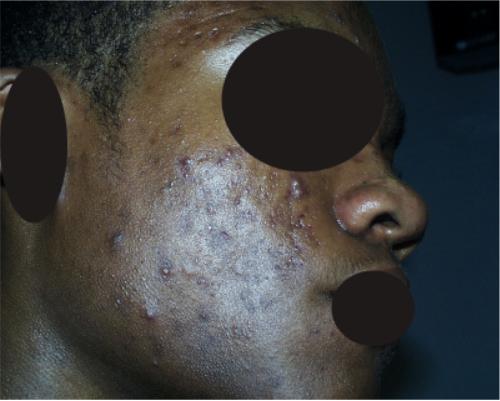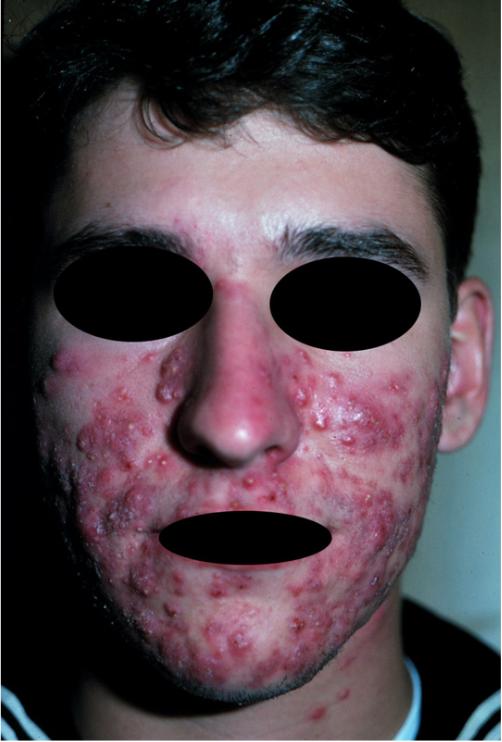Acne
|
All acne treatments require several weeks to work. Your patient will not wake up with a clear face tomorrow, next week or even next month. Be patient! Patients should not "squeeze their zits" because it may enhance scarring and will delay resolution of the manipulated lesion.
Dietary effects on acne are inconsistent at best. If your patient
repeatedly breaks out a couple of days after eating a certain food,
tell him/her to avoid it. However, the complexions of most patients
are not affected by diet. (a) Comedonal (predominantly blackhead/whitehead acne)
Benzoyl Peroxide Benzoyl peroxide products
will induce some drying. If you decide to start a patient on a wash
and a gel/cream together, remember that you may end up inducing quite
a bit of irritation (see Facial Dryness below).
Retinoids: Tretinoin (Retin-A) Another alternative is the vitamin A derivative tretinoin. Facial irritation and dryness are the usual limiting factors for this medication. Most of the time this can either be avoided or minimized if some simple common sense guidelines are followed.
Start using the lower concentration of the
appropriate medication. For patients with very greasy complexions,
the 0.01% gel (green label) is appropriate while the 0.025% cream
(gray label) is better tolerated by average complexions. Application
should be just before sleep waiting at least 20-30 minutes after
washing the face. Significant facial irritation, dryness, and scaling
can be practically guaranteed if this is ignored. Only a "pea sized"
amount of Retin-A is needed to cover a face and forehead. Avoid the
skin immediately adjacent to the mouth, nose, and eyes. A mild amount of irritation will occur and can usually be controlled (see Facial Dryness below). Another way to minimize irritation is to have your patient use Retin-A every other night for 2 weeks before advancing to every night treatment. Retin-A is not a true photosensitizer in the classic sense of the word. It does however make the face more sensitive to all potential irritants such as sunlight, wind, salt water, fragrances, and/or irritating vapors.
Retin-A will make acne worse for a several
weeks before it begins to improve. If your patient tolerates the
initial therapy, you can advance after 3-4 months to the 0.025% gel or
the 0.05% cream as appropriate.
If your patients complain about excessive
irritation from Retin-A, ask them in some detail how they are using
the product. You may be quite surprised to find that they have either
never been told how to correctly use it or just have not followed the
directions. Alternative topical retinoids such as microsphere tretinoin and adapalene gel (Differin®) are niche products that are not widely used due to their expense. Ensure that your patient has CORRECTLY used Retin-A before trying these products.
(b) Facial
Dryness and Irritation from Acne Therapy Topical acne therapy will always create some mild dryness and irritation. It is usually easily controlled with a non-fragranced facial lotions (e.g. Purpose Facial Lotion, Lubriderm etc.) applied once or twice a day. Some facial drying is acceptable; a lot of dryness and irritation is not acceptable. If severe drying or irritation occurs, your patient needs to stop the treatment.
(c) Papulopustular
Acne (red pimples, pustules, no cysts) Benzoyl peroxide products are appropriate (as above).
(d)
Topical
Antibiotics These must be applied twice a day to be effective. Most of them are compounded in water/alcohol based solutions (Cleocin-T, T-Stat, Staticin, and Erycette Pads) and will induce some drying. Patients with complexions that are prone to dryness (or who also have seborrheic dermatitis) should use Cleocin-T Lotion instead of the water/alcohol products. Patients taking disulfuram (Antabuse) should not use these water/alcohol products.
(e)
Azaleic Acid
A newer product is 20% azeleic acid
cream. This is a niche product primarily meant for resistant cases of
simple papulopustular, inflammatory acne. This product is quite
expensive and will have only limited use in a primary care setting.
(f) Oral Antibiotics
These are appropriate for patients with
substantial numbers of inflamed acne lesions and a few small cysts.
Tetracycline
Tetracycline is the old standby.
Unfortunately, it must be taken 1 hour before eating or 2 hours after
eating... a real inconvenience. Particularly avoid dairy products,
iron, and certain antacids. These interfere with the intestinal
absorption of the medication. Start with 250 mg BID advancing to 250
mg (2) BID if needed. Side effects to consider are mostly G-I upset
and candida vaginitis. Photosensitivity, while reported, is not a
frequent problem.
Whether or not the tetracyclines interfere
with the action of oral contraceptives is controversial. It would be
prudent to counsel the patient about this issue and broach the
possibility of using a supplemental form of contraception. The
patient who has been previously stable on oral contraceptives should
immediately report the new appearance of “spotting” to you. This
potential problem has not been reported with Depo-Provera or Norplant.
Doxycycline
This cousin of tetracycline has the
advantage of being able to be taken with food (although not large
amounts of dairy products, or mineral supplements). In fact, taking
it on an empty stomach is usually rewarded by G-I upset. As with all
oral antibiotics, vaginal candidiasis is a possibility. The starting
dose is 100 mg per day advancing to 100 mg BID if necessary.
Photosensitivity is a real possibility
with this drug. It should be used with caution to those with
significant sunlight exposure. Although it appears to be allowed by
the Naval Aerospace Medical Institute (NAMI) for patients in flight
status, a review of the current NAMI, Air Force, or Army flight
medicine "allowable medications" list is highly advised. If in doubt,
consult a flight surgeon from the appropriate service. It is not to
be given to those in undersea status or patients in whom large
exposures of ultraviolet light are probable.
Minocycline
This is another first cousin of
tetracycline that should be taken with food as above. The side effect
spectrum is the same as other tetracyclines. The risk of
photosensitivity is much less than doxycycline. Headaches and vertigo
are a real possibility. The starting dose is 100 mg per day advancing
to 100 mg BID if necessary. It is contraindicated for aviation or
undersea personnel in the Navy.
Erythromycin
This drug is best given on an empty
stomach with two glasses of water. However, if G-I upset occurs, it
can be given with a small amount of food, but about 20 percent of the
drug will not be absorbed. Vaginal candidiasis is a possibility. The
starting dose is 250 mg BID, advancing to 500 mg BID if needed. Beware of multiple drug interactions: theophylline, digoxin, terfenadine, astemizole, loritidine, coumadin, barbiturates, phenytoin, and carbamazepine. Check the PDR for details.
(g) Other Oral Antibiotics
While many other antibiotics have been
used in the treatment of acne, their use is probably best initiated by
a dermatologist.
(h) Other
Oral Medications
The use of medications to modify the
hormonal milieu of acne is probably best left to the specialist.
(i)
Nodulocystic Acne
Use of the medications above should be
considered initially. Oral medications should be used at the higher
doses listed above. If the patient does not respond within 2-3
months, a dermatology consult is appropriate. The use of isotretinoin
(Accutane) may be indicated.
The decision to use isotretinoin is not a
casual one and should be left to a dermatologist. This medication has
predictable morbidity and teratogenicity as well as requiring monthly
follow-up visits and lab testing (including serum pregnancy testing in
women). The risk of teratogenicity in pregnant women is exceptionally
high.
There are also several military-unique
considerations to using this medication. In addition to the
predictable dryness and skin fragility, frequent musculoskeletal side
effects will further degrade combat readiness of personnel in a large
number of military occupations. The dermatologist is obligated to
coordinate this treatment and follow up with the service member's
operational primary care provider.
Written and revised by CAPT Dennis A. Vidmar, MC, USN, Department of Military and Emergency Medicine, and Department of Dermatology, Uniformed Services University of the Health Sciences, Bethesda, MD (1999). *Additional images provided by CAPT Vidmar in June, 2000, subsequent to the initial publication of this manual. |
Preface · Administrative Section · Clinical Section
The
General Medical Officer Manual , NAVMEDPUB 5134, January 1, 2000
Bureau
of Medicine and Surgery, Department of the Navy, 2300 E Street NW, Washington, D.C.,
20372-5300
This web version of The General Medical Officer Manual, NAVMEDPUB 5134 is provided by The Brookside Associates Medical Education Division. It contains original contents from the official US Navy version, but has been reformatted for web access and includes advertising and links that were not present in the original version. This web version has not been approved by the Department of the Navy or the Department of Defense. The presence of any advertising on these pages does not constitute an endorsement of that product or service by either the Department of Defense or the Brookside Associates. The Brookside Associates is a private organization, not affiliated with the United States Department of Defense. All material in this version is unclassified. This formatting © 2006 Medical Education Division, Brookside Associates, Ltd. All rights reserved.
Home · Textbooks and Manuals · Videos · Lectures · Distance Learning · Training · Operational Safety · Search
|
|
|
This website is dedicated to the development and dissemination of medical information that may be useful to those who practice Operational Medicine. This website is privately-held and not connected to any governmental agency. The views expressed here are those of the authors, and unless otherwise noted, do not necessarily reflect the views of
the Brookside Associates, Ltd., any governmental or private organizations. All writings, discussions, and publications on this website are unclassified.
© 2006 Medical Education Division, Brookside Associates, Ltd. All rights reserved
Other Brookside Products


